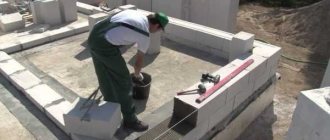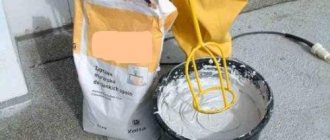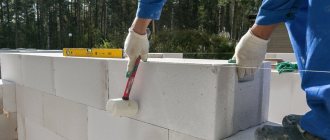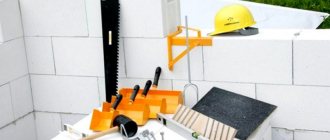In aerated concrete construction, a special adhesive is used, which is an initially dry substance. It is diluted in water in the proportions indicated by the manufacturer on the packaging. This adhesive is suitable for both external and internal construction work. Specifically it is used for:
- Laying aerated concrete blocks;
- Leveling wall surfaces;
- Laying ceramic tiles.
What is aerated concrete adhesive?
It is usually produced in the form of dry powders, which are packaged in paper bags with a capacity of 25 kilograms. Manufacturers write about the amount of liquid that is needed to prepare the solution. Only complete compliance with proportions allows you to preserve the necessary qualities.
1 bag requires an average of 5.5 liters of water.
Advantages and disadvantages of aerated concrete adhesive
Adhesive for aerated concrete blocks is practically free of disadvantages. Most users note only positive aspects. One of them is thermal conductivity. In the case of cement compositions, it is ensured by the fineness of the fillers and binder grinds.
In polyurethane mixtures, the air-filled structure is responsible for the same quality.
There are other advantages:
- No shrinkage.
- Maintaining vapor permeability and water-repellent properties at the same time.
- Less water consumption compared to cement-sand compositions. For foam, this component is generally unnecessary.
- High adhesive properties.
- Plastic.
- Homogeneous structure.
A conditional disadvantage could be called rapid setting, due to which there is little time left for adjusting the block when installation is performed. Solutions cannot boast of high viability.
It is better to make batches in small batches. Adhesive for cellular concrete also requires this.
| Characteristic | Average indicator |
| Time range during which the mixture mixed with water can be used | 4 hours |
| The length of time during which you can adjust the block in the masonry | 15 minutes |
| Frost resistance | 35 cycles |
| Adhesion | 1.2 MPa |
| Thermal conductivity | 0.28 W/m*S |
| Water holding capacity | 97% |
| Brand strength | M100 |
| Total compressive strength | Arrives in 28 days |
| Hardening | During the day |
| Consumption of glue (cement) per 1 m³, with an average joint thickness of 2.5-3 mm | 25 kg |
Material consumption
Consumption depends not only on the volume of the block, but also on the quality.
As experts note, the consumption of aerated concrete adhesive per m3 of masonry depends on the size of the “bricks”, the condition of the surface of the blocks, that is, the accuracy of their geometry, the presence of defects (cracks, chips, etc.), as well as the skill of the builders. As practice shows, on average one and a half bags of dry base are used per m3.
To determine more precisely, they offer certain formulas that are convenient for calculating the consumption of dry glue in kilograms per m3 of masonry, based on the length, height of the gas blocks, and thickness of the seams.
Return to contents
Types and types of glue
In total, two main types of material have been developed:
- Thin layer. An excellent option when laying gas blocks with a flat surface or slight deviations from the geometric shape. For high adhesion strength, a layer of 2.5-4 millimeters is sufficient.
- Thick-layer. Here the thickness will be 10-15 millimeters. For uneven surfaces and in the presence of chips. This thickness is needed to level the blocks in height and reduce existing defects to a minimum.
Technical characteristics allow us to distinguish winter and summer varieties. The composition of the aerated concrete adhesive changes slightly.
Winter glue
It contains a number of modifiers that have a positive effect on the overall level of plasticity and frost resistance. It takes longer to dry compared to summer formulations. But the grip retains high strength for a long time.
Masonry can be organized at temperatures up to 10-12 degrees below zero. This is especially important for regions with harsh climates and winters lasting 6-9 months. This adhesive for cellular concrete blocks is a universal product that can be used at any time of the year.
Summer glue
Here the base is white Portland cement. After hardening, the seams remain white and do not begin to darken. Thanks to this, walls made of cellular blocks have a neat appearance and do not require additional processing.
But the air temperature should remain within 5 degrees above zero. Otherwise, the adhesive and elastic properties are lost.
Where is it used?
Adhesive for aerated concrete is a special dry construction mixture, which is diluted with water in the proportions specified by the manufacturer. It is used instead of conventional cement mortars for both external and internal work.
Use it for:
- masonry of blocks made of gas and foam concrete, expanded clay and cinder blocks, bricks;
- leveling wall surfaces, puttingty them;
- laying ceramic tiles.
Return to contents
How to prepare glue
The main thing is to carefully study the instructions from manufacturers producing compositions for cellular blocks. The exact proportions are indicated there.
Compliance with the following rules makes it easier to obtain high-quality results:
- Using warm water for mixing.
- First, the dry mixture is poured into water; the opposite cannot be done.
- Only a construction mixer with low speed produces a mixture of the correct consistency.
- Masonry adhesive is mixed in heated rooms if it is winter outside. The temperature is not lower than plus ten degrees.
- With summer glue, the working time after mixing is a maximum of 30-40 minutes. In the case of winter, everything must be used up in 2-3 hours.
Professionals prefer to prepare solutions in two stages. First comes the first batch, then wait 2-3 minutes. All that remains is to mix everything again and begin distributing the material over the surface of the blocks.
The adhesion will not be strong if dirt and dust remain on the surface.
Works in winter
For masonry in cold weather, a gray winter composition is used. However, as we have already mentioned, there is also a certain threshold for it (the “overboard” temperature cannot be lower than -10 °C; manufacturers usually recommend a value of 5 °C). For the solution itself, the temperature is maintained above zero - only if this condition is met, good adhesion of the materials is ensured.
Note. Do not glue frozen blocks covered with snow together - this is not allowed according to technology.
Return to contents
Adhesive foam for aerated concrete blocks
This is a polyurethane composition that was developed as an alternative to conventional dry adhesive mixtures.
A foaming type of mass that is packaged in sealed containers. It is applied with a construction pistol. In this case, everyone decides for themselves which glue is the best.
Composition and characteristics of adhesive foam
The adhesive in cylinders is based on polyurethane. It is foamed using pistols. This is a moisture-resistant type of polymer. It is durable and protected from acids and oils. Heat-resistant material capable of creating a rigid and at the same time durable fastening.
Advantages and disadvantages
The positive aspects of polyurethane glue include:
- High speed masonry.
- Convenient work. There is no need to buy mixers and containers or waste time preparing the solution.
- Protection from mechanical influences.
- High adhesion strength to various concrete blocks, bricks and stones.
- Lack of water in the composition. Because of this, the hardening speed becomes maximum, making it possible to use at temperatures down to -10 degrees.
The gun helps to obtain very thin and neat seams when aerated concrete blocks are processed.
But there are also some disadvantages that it is also advisable to know about in advance:
- Adhesive foam is more expensive compared to analogues.
- The best quality is obtained only when working with even blocks. Any defects require some time and effort to eliminate.
- Fast hardening. Blocks are adjusted only three minutes in advance, no later.
- Can be used for load-bearing walls, but only if there are 1-2 floors in the building.
“Age” is one of the most important factors that professionals pay attention to. The compositions simply did not have time to stand the test of time, since they appeared relatively recently. Not everyone knows exactly how many years ago.
General provisions
Let's take a closer look at what happens if antifreeze additives are not applied to concrete, but simply continue construction work.
The fact is that this solution contains a certain proportion of water, therefore:
- The liquid crystallizes, almost completely stopping the hardening process of the concrete mixture.
- H2O expands and creates cavities in the whole structure, decompressing it.
- The level of adhesion of cement stone drops sharply.
- The masonry becomes loose and will not last long.
Thus, concrete must be protected from freezing until it reaches a certain critical mass, after which the hardening process cannot be stopped.
Concrete with antifreeze additives hardens efficiently even at sub-zero temperatures
Top best manufacturers
This rating helps you navigate the modern market. But any such listing can be called conditional, since it was formed according to the reviews of professionals.
The list includes safe materials that have passed all the necessary tests and showed excellent performance during the operation of finished buildings. The thickness of the seam during laying is also optimal.
Ceresit
The company produces excellent ones for work carried out inside or outside. Standard packaging: 25 kilograms. There are approximately 10 minutes left to adjust the blocks. For 1 m2 with a layer of a millimeter it takes 1.46 kilograms.
| Glue brand | Specifications and price |
| Cement adhesive Ceresit ST-21 | Universal adhesive ST-21 is waterproof and frost-resistant (withstands 75 freeze-thaw cycles), and adheres well to the surfaces of aerated concrete blocks. Designed for thin-seam masonry - which means the blocks must be category 1.
|
| Foam glue Ceresit CT 115 | This manufacturer immediately stipulates that this glue should only be used for laying non-load-bearing walls. It has high adhesion, is productive and economical. One 0.85 l cartridge is enough for 10 m² of partition walls built from 600*250*100 mm blocks. Characteristics:
|
Perel Blokus
They are also known for their superplastic adhesive mixtures with a cement-lime base and polymer additives. Thanks to the 2-5 millimeter seam, the formation of so-called “cold bridges” is completely eliminated.
Baumit Plano fix
They produce varieties of adhesives for aerated concrete blocks that have a whole range of advantages:
- Convenient to use.
- Adhesive ability.
- Vapor permeability.
- Frost resistance.
- High plasticity.
- Environmentally friendly.
- Moisture resistance.
- Elasticity.
Can be used for both interior and exterior work in apartments and beyond. The main positive feature is the strength of adhesion to the base.
Kreisel porenbetonkleber
The company focuses on thin seams. Helps to build aerated concrete walls from blocks.
The advantages are described as follows, which allowed us to enter the rating:
- High adhesion rate.
- Temperature range of use from minus ten to +30 degrees.
- Thin seams from 1 millimeter.
- High frost resistance.
- Heat resistance.
Adviсe
When choosing a particular brand of glue, you should be guided by the following criteria.
Manufacturer's name. Very often there are insidious fly-by-night companies that produce low-quality promotional materials, which turn out to be fictitious and do not bring the desired result, and sometimes even harm the building. In order not to make a mistake and not fall for the bait of scammers, it is better to trust well-known and trusted brands, and also remember that a quality product cannot be cheap.
Packaging and storage conditions
When choosing a product in a warehouse, immediately pay attention to how it is stored. High humidity in the room, sudden changes in temperature, damage to packaging, a bag with blurry letters and a company logo - all these are clear evidence of a poor-quality mixture
This material is so good, provided that the rules for its storage are followed, but how disgusting it is when at least one parameter does not correspond to reality.
By weight. Never agree to purchase glue for gas silicate blocks without packaging. No one can give you a 100% guarantee that there are no low-quality impurities.
Having decided on the brand of glue manufacturer for gas silicate blocks, you can begin to calculate the material consumption. Often, all companies indicate this value on the packaging of their products, however, this information is only a reference, so for each individual case it is necessary to calculate the glue consumption per cube of blocks individually.
The main parameter on which the amount of solution consumption per 1 m3 depends is the layer thickness. If this figure is no more than 3 mm, then the amount of glue will average from 8 to 9 kg per cubic meter. With a layer thickness of 3 mm or more, the consumption of the finished mixture increases 3 times and amounts to 24-28 kg for the same surface area.
To somehow optimize glue consumption, you can resort to the following technological tricks.
- Surface preparation. One of the important criteria when laying gas silicate blocks using specialized glue is ideal evenness. The smoother the blocks, the less construction mixture consumption will be.
- Compliance with the solution preparation technology. Simply taking and kneading glue for laying gas silicate blocks, like dough for pie, will not work. It also has its own system: firstly, the glue powder is poured directly into water collected in a clean container (a plastic or galvanized bucket is ideal); secondly, stirring occurs in two stages, with a short break (5-7 minutes, no more); thirdly, you should not apply a large volume of the mixture at once, since you may not have time to use it all before it hardens (for most manufacturers this time is limited to 2 hours).
- Application methods also play an important role in reducing glue consumption. For example, the main tool for laying the mixture is a spatula with teeth. It is better to lay gas silicate blocks 10 minutes after applying the glue, pressing firmly and tapping the surface with a rubber hammer.
The first row of blocks is never placed on glue. There is always a foundation under the initial “line” of the entire structure: concrete screed, screw piles, etc. This way the entire building will be much more stable and durable.
These are the main tricks that need to be used in work to minimize the consumption of glue for gas silicate structures without compromising quality.
In order to position the blocks as accurately as possible, and the adhesive layers between them, it is necessary to use mixtures intended for a specific individual case: for interior or exterior work, for laying gas silicate blocks at high or low temperatures.
It is also necessary to remember that the minimum curing time for glue in a block or panel structure is 24 hours. But the best and final result is observed no earlier than the third day after installation.
Compliance with the basic indicators of temperature and humidity allows the construction of a gas silicate structure using special glue quickly, simply and efficiently, even for a novice builder who does not have additional skills or education
Of course, it is very important to enlist the support of professional masons and experienced builders in this difficult task, so that later you can only rejoice and enjoy the positive results of your own efforts
To learn how to choose glue for gas silicate blocks, see the following video.
Common mistakes
Several categories of errors can be distinguished depending on the consequences that appear later.
Actions that violate the integrity of structures
Any miscalculations in the future increase the likelihood of cracks forming. In turn, they lead to a decrease in strength and collapse.
Here is a list of the main errors that are most often encountered in practice:
- The use of bricks to protect insulation together with expanded polystyrene.
- Mistakes associated with bandaging or mating. Creating flexible connections can be called a mistake.
- Armored belts are incorrectly positioned or absent altogether.
- Incorrect arrangement of the foundation, erroneous choice of soil or type of structure, use of different types of foundation in the same building.
- The structure of the trees located nearby was not taken into account.
- Lack of compaction and improper work with underlying layers.
Which leads to unnecessary labor and financial costs
It is because of the mistakes described above that owners have to spend much more money, while none of the expenses pay off. It also takes more time, although the final quality does not change in any way.
The use of ceramic bricks in the first rows is not able to correct mistakes made when arranging the foundation. You should not install reinforcement where it is not initially required.
Additional information about installation technologies
Already at the preliminary stages, the following actions are carried out so that the strength of the masonry becomes maximum:
- Preparation of the solution. A good composition requires special attention.
- Checking the foundation in all areas. It should remain as horizontal as possible throughout.
- Provide additional protection from moisture using bitumen mastic.
Roofing felt for waterproofing is not as effective, but in some situations it can replace analogues.
More detailed description of the technology
The acquired knowledge and skills help to create durable and smooth surfaces that have all the necessary characteristics.
The first element is laid or installed in the corner. Then they continue to move sequentially until the next turn. A thickened layer of mortar helps to cope with any possible defects in the foundation. The main thing is that the height of the corners is approximately the same. The deviation should not exceed 3 centimeters.
When used correctly, the approximate cord also creates the most even line possible. To achieve this effect and maintain it, you need to pull this cord with corner blocks, with the obligatory use of intermediate beacons. At this stage, building levels become indispensable assistants. A hacksaw is used when adjusting blocks when it comes to structures of increased complexity.
Reinforcement is required not only for the space under the windows, but also for rows with numbers divisible by five.
Laying with glue is carried out only in a certain temperature range, from -5 to +20-25 degrees. If the days are hot, the material can be slightly moistened while working. Protective awnings or films are necessary when precipitation is present. Then the seam and masonry will dry correctly.
A stainless steel bond is required when it is necessary to create areas where walls join together with internal partitions. As a result of this work, a seam appears, which can only be fixed with ordinary nails. It is recommended to add such components to each even row of masonry.
When construction is completed, natural shrinkage occurs, which takes up to several months.
About reinforcement
When reinforcing, several problems are solved during installation:
- Strengthening those areas where the masonry is weakened. This is mandatory for all types of openings.
- Providing additional protection for the building perimeter. It is especially important with an increased degree of ventilation and during shrinkage, in case of temperature changes.
- With vertical reinforcement, it becomes possible to combine the base with a monolithic frame. Such approaches are relevant for regions with increased ground displacement and hurricanes.
The frame is made of steel wire, usually everything is arranged in one layer. The reinforcement elements are located parallel to each other. It doesn’t matter whether it’s an apartment or another object.
You need to create two grooves using a wall chaser. Then they are soaked in water and filled halfway with glue. It is necessary to place it inside fittings with a standard size of 8 millimeters. Next, everything is filled to the brim with the binding composition. Using adhesives is not that difficult.
How to check the correctness of the masonry?
The evenness of those laid side by side is checked regularly while construction is underway. The same applies to the thickness of the adhesive layer, which is used for strengthening. Construction measurements require a minimum set of tools:
- Building level.
- Rule.
- Ruler.
During the inspection, the rule is leaned against a section of the wall that has already been erected. If everything is according to technology, then there will be a tight connection. A building level is placed on top of the stacked blocks. His readings should be enough to determine the horizontal line.
The site must be rebuilt if there are any deviations. Otherwise, the masonry will not be of high quality.
Before starting work, a foam container must be prepared. To do this, it is placed in a warm room for 10-12 hours. In warm weather, you can do without these steps.
It is recommended to apply several vertical strips of glue at once to ensure a better bond. If a gun is used, keep the cylinder in an inverted position. The nozzle, which looks like a truncated body, is located a centimeter from the surface of the block.
The thickness of the block itself determines exactly how many stripes are applied to the surface. The width of these strips themselves is 2-3 centimeters. The main thing is that they are not interrupted. Various modern technologies are used for installation.
Operation technology
The use of antifreeze additives in concrete is allowed only taking into account compliance with all necessary safety conditions:
- Storage away from open fire and other fire hazardous places, since the components involved in the creation of the solution in question are prone to fire and even explosive.
- During operation, personal protective equipment is required. Contact of drops or vapors of the modifying mixture into the oral cavity or respiratory organs results in poisoning, and injury to exposed skin and eyes.
Examples of suitable personal protective equipment
The following are simple instructions:
- You begin to mix cement, which has no modifications, in a concrete mixer.
- While the machine is running, dilute the purchased mixture with water according to the accompanying instructions.
- The diluted composition is poured into the total mass of concrete, where it becomes homogeneous.
- After pouring the resulting solution, it is advisable to additionally cover it with wooden shields. After all, you don’t know how severe frosts can hit in the next couple of weeks, and extra precaution won’t hurt.
Foundation erected at sub-zero temperatures due to the presence of anti-frost additives in its composition











